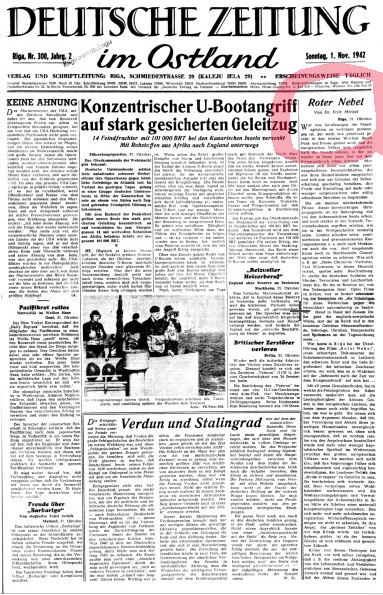- Home
- POSTER GALLERY
- ❗️BOOK & POSTER STORE❗️
- PURCHASE "HJ Quex" film ephemera HQ
- About the Posters
- The William Gillespie Collection
- Our Publishing House
- ❗️GFDN interviews author and collector William Gillespie ❗️
- Our most expensive & inexpensive finds!
- ❗️***NEW!**❗️POSTER OF THE MONTH - Blutzeugen / Raza
- ❗️NEW ❗️Film Posters – Demands on an important means of film advertising. ❗️
- In our Book + Zeitschrift Library
- ❗️ ***NEW!*** Hitler Youth Quex – A Guide for the English–speaking Reader ***NEW!*** ❗️
- ❗️***NEW!*** Table of Contents of our new HJ QUEX book❗️
- ❗️Hitler Youth Quex Guide - early praise! ❗️
- Recent loans from the Collection
- Farewell Horst Claus. (1940–2024 †)
- "Der Deutsche Film" Zeitschrift
- ❗️ ***NEW!***Reichsfilmkammer collection ❗️
- German "Tendency" Films (Tendenzfilme) in the Third Reich
- KARL RITTER
- Karl Ritter original film posers in this Collection
- "Besatzung Dora" ( † 1943)
- "The Making of The Crew of the Dora"
- Karl Ritter at the 1938 Reichsfilmkammer Congress
- INDEX -"Karl Ritter" book, 2nd edition
- Karl Ritter's Legion Condor (1939, unfinished)
- Excerpt from our "Dora" book
- ∆∆∆∆∆ High praise for our DORA book! ∆∆∆∆∆
- TABLE OF CONTENTS – "Legion Condor"
- § § § § § Early Praise for our LEGION CONDOR book! § § § § §
- ❗️"Das Leben geht weiter" and Karl Ritter ❗️
- Dateline: Ufa - April 11, 1945
- Zarah Leander Europe–wide !
- Japan Military Film and Karl Ritter
- Karl Ritter after 1945
- 1935 Film Congress
- Poster Exhibition in Berlin, March 1939
- Potsdam poster exhibition 12 April–25 August 2019
- Leni Riefenstahl's two "Olympia" Films (1938)
- "Ohm Krüger" (1941)
- Emil Jannings
- "Blutendes Deutschland" (1933)
- Hannes Stelzer ( † 1944)
- Klaus Detlef Sierck ( † 1944)
- Film stills
- Reich Film Censorship Offices
- ❗️***NEW!***The Fate of the German Film Industry in May 1945 ❗️
- Film censorship cards
- Film Archives
- Cinema advertising
- School filmstrips
- ❗️UPDATED❗️ Z F O / Ostland Film G-m-b-H
- Z F O / Herbert Jacobi estate
- ZFO / Ostland Film newspaper articles
- ❗️***NEW!*** Roter Nebel / Red Fog / Red Mist (1942/1943, ZFO) ❗️
- ZFO - Der Rückkehrer - The Returnee (1943/1944)
- The D F G production company
- D I F U
- ❗️ ***NEW!*** "Carl Peters" – Special Collection. ❗️
- "Alcazar" (1940, Genina)
- "Der 5. Juni" (1943, banned)
- Herbert Selpin and his "Titanic" (1943)
- Ein Robinson (1940, Fanck)
- "Fronttheater" (1942)
- Veit Harlan's Jud Süß and Fritz Hippler's Der Ewige Jude
- Harlan "Jud Süß" trial 1949
- Werner Krauss & JUD SÜß
- Anti-Semitic Film Posters in the Collection
- "Heimkehr" (1941)
- "Hitlerjunge Quex" (1933)
- ❗️***NEW!*** Hitlerjunge Quex in 111 Greater Berlin Cinemas ❗️
- Jürgen Ohlsen
- "S.A.Mann Brand" (1933)
- "In der roten Hölle" (Edgar Neville, 1939)
- "Helden in Spanien" (1938)
- The Spanish Civil War in Film
- Andrews Engelmann (1901 – 1992)
- Deutsche Wochenschau
- Uƒa Feldpost
- Uƒa Kulturfilm – Informationen
- " Die Tochter des Samurai" (1937, Fanck)
- Ufa 25th Anniversary
- Invitations to world premieres
- ❗️***NEW!*** Continental Films, Paris 1940–1944 ❗️
- Film Censorship in Occupied Paris 1942
- "Der Sieg des Glaubens" (1933)
- Wilhelm Althaus Estate
- Weimar Germany posters
- Ufa and the Ordensburgen
- The Gaufilmstelle in our Collection
- "Zwei Welten" (1940)
- "Capriccio" (1938) –Karl Ritter film album
- Unrealised NS Propaganda Films 1934–1945
- German Film Directors accused of "war crimes"
- Australian––themed NS feature films
- "Der Störenfried" / "The Troublemaker"
- What was new in 2014?
- What was new in 2015?
- What was new in 2016?
- What was new in 2017?
- What was new in 2018?
- What was new in 2019?
- What was new in 2020?
- What was new in 2021?
- What was new in 2022?
- What was new in 2023 ?
- What's new in 2024?
- ❗️***NEW!*** Hitler assassination attempt in Karl Ritter film cut❗️
- BESATZUNG DORA private photos
- Just discovered 1942 article on BESATZUNG DORA
- The Karl Ritter Tetralogy
- Google Analytics 2023
- Our first–ever acquisition!
- ❤️"Some of our favourite things....!"❤️
- ERRATUM for our " Hitler Youth Quex Guide"
- Trending
- Vale †
- Our Wants List / 2024 / Wunschliste
- Pop Quiz
- Unsere KARL RITTER Bücher in Deutschland liefbar!
- WHERE to buy our books right now?
- ✉️Contact
 “History is not about the facts. It is about the context and who is telling the story.” —Prof. Milton Fine.
“History is not about the facts. It is about the context and who is telling the story.” —Prof. Milton Fine.
"Who controls the past controls the future: who controls the present controls the past." –– George Orwell in his novel "1984."
"Whoever doubts the exclusive guilt of Germany for the Second World War destroys the foundation of post–war politics." –– Prof. Theodor Eschenberg, Rector, the University of Tübingen.
"If we have our own why in life, we shall get along with almost any how." – Friedrich Nietzsche
POSTER GALLERY --view
over 500 German film
original posters between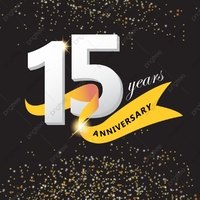
1927–1954 from
Germany and from
many Axis and Neutral countries
across Europe!
Note! Posters in the Poster Gallery are PERMANENT
acquisitions which are NOT FOR SALE!! ONLY the
posters listed in our POSTER STORE are for sale.
(They have a price and order button to use.)

The following nine newspaper articles and film reviews appeared in the German newspaper Deutsche Zeitung im Osten published in Riga, Latvia during WWII. The date of each article in cited at the top of each article's section. None of these articles are cited in the standard reference works on the ZFO/Ostland Film; which all rely on articles in the Berlin Film-Kurier Tageszeitung newspaper, and which are completely different articles.
All nine articles © 2020–2021 Translation by German Films Dot Net. All rights reserved.
––––––––––––––––––––––––––––––––––––––
from Deutsche Zeitung im Osten Riga, 9. September 1942

"The Eternal Jew” film review
"Aina" and "Daile" have been showing in the two Riga cinemas since Monday the documentary film "The Eternal Jew.” The film was shown a long time ago in most cinemas in the Reich.
The fact that it has now found its way to Riga is particularly to be welcomed as it is now in this land that the devastating and destructive activity of Judaism is freshly recalled. For one thing, it is less necessary here than elsewhere to highlight the dangers that Europe and the world face threatened by the claim to power of Judaism, whose anger one has experienced in one's own body. On the other hand for those who were able to get to know the Jews in their unbridled lust for murder, the essential facts and backgrounds are of the greatest interest, in which one can recognize the world-threatening and misanthropic attitude that has been inferior to all human races since ancient times.
The film mercilessly tears the mask off the face of Judaism, shows the murderous grimace of the eternal destroyer, who is often camouflaged behind cunning and submissiveness. shows his heartless and ice-cold cruelty, as we see it especially in the slaughter scenes, and makes it understandable why it was possible that the Jew and only he could not only organize the greatest mass murders in world history, but also in a broader sense could organize carrying out cases single-handedly, able to perform in a manner which is even under the level of animals. Of particular interest are the original recordings of films that were made under Jewish management in America for Jews themselves and that shine into a truly depraved and polluted soul. You can also see in amazement the ability of the Jews to change and camouflage themselves, who penetrate from their eastern ghettos into the heart of Europe and now adapt outwardly to the European environment, stifles an often unsuspecting community all the more often to be able to grab in his predatory hands.
Shudders fill us from scene to scene that roll by, shudders, but also the deepest sense of satisfaction that the hour has now come when this insidious enemy of European morality and culture will be finally wiped out from the life of our continent after it has been exposed.
--------
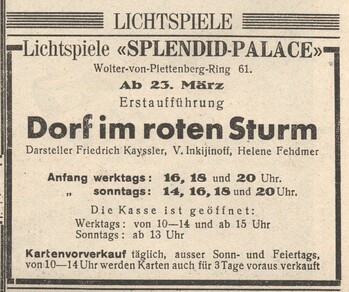
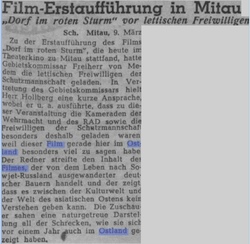
–––––––––––-––––––––––––––––––––––––––––
from Deutsche Zeitung im Osten, 10. März 1942
Film premiere in Mitau
"Village in the Red Storm" in front of Latvian volunteers
Area Commissioner Freiherr von Medem had invited the Latvian volunteers of the Schutzmannschaft to the premiere of the film "Village in the Red Storm", which took place today in the theater cinema in Mitau. On behalf of the area commissioner, Mr. Hollberg gave a short speech.
He stated that the comrades of the Wehrmacht and the RAD as well as the volunteers of the Schutzmannschaft were invited to this event because this film had a lot to say here in the East.
The speaker touched on the content of the film, which is about the life of German farmers who emigrated to Soviet Russia and which shows that there cannot be any understanding between the cultural world and the world of the Asian East. The audience saw a true-to-life representation of all the horrors as they also appeared a year ago in Ostland.
–––––––––––––––––––––––––
from Deutsche Zeitung im Osten Riga, 1. August 1942
Not only propaganda films were produced by Ostland Film GmbH in these war years. Cultural films, such as one on the famus Riga Ballet company, were also released, as per this article from August 1942:
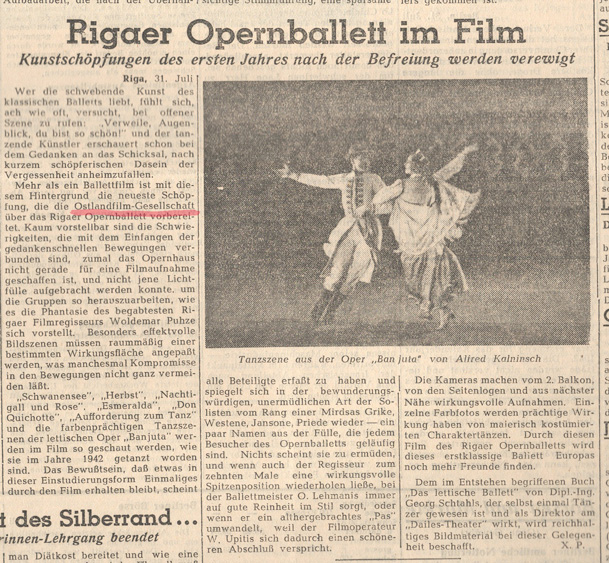
In September 2022 we received from an Italian collector 20 minutes, 46 seconds of silent film from this documentary. Below is a screen shot:

––––––––––––––––––––––––––––----------------------------------
from Deutsche Zeitung im Osten Riga, 1. November 1942
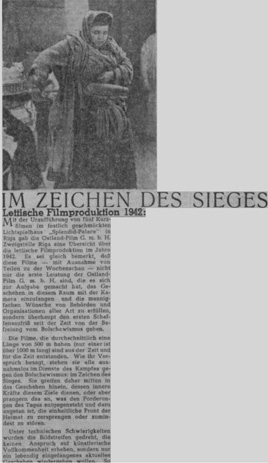
IN THE SIGN OF VICTORY
Latvian film production 1942
With the world premiere of five short films in the festively decorated theater "Splendid-Palace" in Riga gave the Ostland-Film G. m. b. H. Riga branch an overview of the Latvian film production in the year 1942. It should be noted at once that these films - with the exception of excerpts from the newsreel - are not just the first performance of Ostland-Film G. m. b. H., who have made it their mission to capture what is happening in this space with the camera and to fulfill the manifold wishes of authorities and organizations of all kinds, but also to give the first creative outline since the time of the liberation from Bolshevism.
The films, which have an average length of 500 m (only one is over 1000 m long), were made out of our time and for all time. As their preamble indicates, they are all without exception in the service of the struggle against Bolshevism: under the sign of victory. They therefore reach into the centre of what is happening, the inner forces of which serve this goal, or else denounce what is contrary to the demands of the day and what is appropriate for it, the unified front.
The picture footage was shot under technical difficulties. They do not claim to be artistic perfection, but only want to reproduce current events captured in a lively manner. The result is gripping documentaries that will certainly mean more to all those who will soon see them in the cinemas than just a cheap means of spending a free period of time.
They are aimed at all segments of the population, and there will be no one who can ignore their call. The prelude to the screening was formed by images made up of parts of newsreels compiled for the premiere of five new short films in Riga, which showed the "Share of the Latvian people in the great struggle against Bolshevism.” Back in the middle of the big wool and fur collection campaign of the past winter, everyone saw the events of the past year that moved the Latvian population and announced their will to victory.
The films "Our Volunteers in the Reich Labor Service" and "Skill is Gold", the latter shot on behalf of the Central Group of Professional Associations, showed the Latvian youth who understood the call of the time with joyful hearts.
While the labor service film takes us into the Reich, "Skill is Gold" shows us life in a technical school on Rigas Beach, where Latvian girls are preparing for their future careers. Maximum performance - beauty of work, that is the basic motif of this series of images .
"Bad luck" is the name of a propaganda film against surreptitious trafficking. In splendid scenes we show the criminal behavior of those pests who think only of their own interests and do not think about the concerns of the community and disrupt unscrupulous planning of the national economy.
Leaving the most lasting impression without a doubt the great documentary film "Red Fog - One Year of Bolshevik Rule in Latvia". We will come back to it again; for this juxtaposition of historic recordings, documents and figures shows, in a shocking way, that the ordeal of the Latvian people as it was under the rule of Moscow had to go.
-----------––––––––––––––––
from the Deutsche Zeitung im Osten, 1. November 1942
Red Fog [ film review ]
by Dr. Fritz Michel Riga, October 31
Those of us who are forced to pursue the enemy agitation by professional means, know how penetrating the radio and the press have been sounding in the last few weeks that the European peoples are supposedly longing for the hour in which they can live again in the sense of the time before the outbreak of war. In doing so, they mainly make use of those persistent personalities who have emigrated from their home countries and are now busily trying to justify their escape and attitude with more or less exaggerated or completely fabricated reports for reasons of preservation.
The most recurring phrase in this transparent inflammatory propaganda is the assertion that the Axis powers are already taking terrorist measures today, and even more so in the future, which are unique in world history. London sent its most experienced and unscrupulous correspondents also to Moscow, in order to stir up the atrocity agitation from there, which can hardly be surpassed. What for example, the “News Chronicle” representative, Paul Winterston, does in this regard defies description. He portrayed the German soldiers as murderers, terrorists and corpse collectors, for whom it was routine to make films of the agony of their victims, and he hypocritically calls for the Germans to be ruthlessly punished as "the culprit" for these “ crimes against humanity.” Hand in hand with this filth goes the Anglo-Soviet waltz, according to which there are mass suicides, sabotage, unrest, famines and epidemics in the Reich and in the occupied territories.
Anyone who experienced the seriousness and deep emotion of the Latvian audience at the world premiere of the film "Roter NebeI,” that gruesome document of the Bolshevik rule in Latvia, knows what the truth for the "longing for the time before the outbreak of war“ is about ...
With all the recent atrocity methods through which the fine agitation contaminates the ether, one speculates on the gullibility of the little spirits in the European countries, who today still have not understood what it is about. They allow themselves to be blinded by the argument that the supply and sale of their respective homeland used to be incomparably better, without admitting that it was previously completely controlled by the Anglo-Saxons and that it was more or less a capitalist plaything in the race between the great European peoples. They fail to realize that their governments used to belittle themselves as a love-servant, and selfish to please the London policy of "divido et impera". Rather, they limit themselves to mourning their former wealth and to regard the members of the Wehrmacht and administrative leaders of the Axis powers in their midst as the originators of a materially war-related situation. They fail to recognize economic compensation, as their fear that the "golden age" of before the war would never return is greater than a better belief in a brighter and more just future.
None of these yesteryear had the strength to admit to himself that for example the complete dependence on the food and fodder imports from overseas territories was never normal and healthy, and that the reduction of this situation was undertaken at the very last hour. The fact has long been forgotten that after the World War, England and the USA in particular implemented a kind of "right to self-determination" which put handcuffs openly or covertly on small peoples in particular. The Slovak ties to the Czechs and the Croatians to Serbia is just as powerful evidence as the political exploitation of the Baltic border states by England and their sale to the Soviet Union.
Ben Akiba is right in his wise remark that everything was already there, because anyone who follows British history closely knows that it, like no other history in the world, is made up of the principle of terror and brutal conquest and one ordered by very unique cosmopolitanism - not in the manner of "be embraced, millions", but in the manner of the fox who makes the geese beautiful eyes in order to slowly wring their necks. All the great European wars of the last two centuries had always a double result with Great Britain as the beneficiary: shifts of power and property on the European mainland in the foreground and shifts of maritime and colonial rule in the background. The former always aimed at the respective strongest or strongest mainland powers being weakened, destroyed and broken in balance, no matter whether it is about the domination between the Houses of Habsburg and Bourbon Prussia or the French Revolution and the Napoleonic military empire. The latter resulted in England becoming more and more powerful and developing more and more exclusively into the dominant sea and colonial power, until it finally overshadowed all European competitors with the most powerful world empire in history. It should be instructive for all of us to briefly recall the results that the great continental wars since 1700 had for Europe as for the Empire in particular:
1. ”War of the Spanish Succession 1700-1714. Result in Europe: Habsburg loses Spain, which itself loses most of its foreign lands to Austria. France is impoverished, Sicily becomes independent, Prussia receives Neuchatel and Obergeldern, gives up its claims to orange and is recognized as a kingdom ... Profit for the Empire: Newfoundland with the adjoining islands, Nova Scotia, the Hudson Railroad. St. Christopher, Gibraltar and Menorca, the monopoly of black imports, and other significant commercial advantages in the West Indies. England thus thwarted the plan of a French colonial empire from the Gulf of Mexico to the Lawrence River, and Spain, the old enemy, was weakened again.
2. Seven Years War 1756-1763 and at the same time colonial war between England and France 1755-1763. Result in Europe: Prussia keeps Silesia, Habsburg the German Empire, Prussia becomes a European great power ... Profit for the English Empire: in America Canada including Arcadia and Cap Breton, Louisiana to the Mississippi, Florida, the West Indies Grenada, Grenadia, St. Vincent, Dominica, Tobago, in Africa: the French possessions in Senegal. At the same time the conquest of India begins. France loses all places already won there in the south. Spain's maritime power has almost completely been destroyed, France's colonial empire in America has completely collapsed, while that in India has finally been shaken. In North America, England will master the ocean to the Mississippi, from the Arctic Ocean to the Mexican Gulf. It has become the predominant maritime and colonial power.
3. Revolutionary and Napoleonic Wars 1792-1815. Result in Europe: Napoleon's world empire overthrown, restoration of all five great powers, France rejected within the borders of 1792, Russia receives Congress Poland and the political preponderance on the mainland, Austria and Prussia have been restored to roughly the old extent. Austria is enlarged somewhat towards the east, Prussia is rounded off towards the west and reduced in size. The German Confederation takes the place of the old German Empire. Italy remains fragmented. The "Kingdom of the Netherlands" is founded. Personal union between Sweden and Norway ... Profit for the Empire: in Europe Heligoland, Malta, protectorate over the seven Ionian islands. In America St. Lucia, Trinidad, Isle de France; Honduras secured. In South America British Guyana, Essequibo, Demerara and Berlice, in Africa Cape Country, Mauritius, the Seychelles and Ascension, in Asia Ceylon, great expansions of Indian holdings, Malacca, in Australia Tasmania ... The French fleet is destroyed, French influence in India completely destroyed, the Dutch colonial empire severely weakened. Africa has entered the realm of England's plans for world domination. England has usurped almost all of the world's merchant shipping. The English fleet and English trade have bitten off the preponderance and all unpleasant rivals ...
From the Russo-Turkish War of 1877/78 England fished for itself the important Cyprus and advantages in Afghanistan. Only the three wars of 1864, 1866 and 1870/71, thanks to Bismarck's superior policy, offered no means of profit, which undoubtedly became a strong reason for dislike of the German Reich. England's profits after the World War are as well known as the fact that these profits by no means brought the British any blessing or prosperity. Although British capitalism ate like a prairie fire, it did not succeed in regaining the empire's world power position which it previously held, and all efforts to destroy the new natural sphere of power of the authoritarian states failed. Only there is the real background to be sought for the politics of England's new warmongering and for the hate psychosis that radiates from London into the world. With the outbreak of war the mask fell and John Bull stands before us as he has borrowed and lived for centuries.
Germany and Italy in Europe, like Japan in Asia, have become wise through history. Germany is an inseparable part of the unified axis, Germany and the Axis are bound and armed, and their trust in the final victory is firmly founded on the new spirit that unites us and on the weapons that were created from this spirit. Anyone who does not recognize this spirit and inwardly resists the new knowledge that young healthy peoples must no longer be barred the way to ascent, who would like to perpetuate the state of the “have-nots”, and whoever takes care of the business of our opponents through sabotage or passive resistance and cooperation with the enemy, should not be surprised when drastic countermeasures are taken. Antidotes that have the sole purpose of not allowing the block of will and strength to be undermined, but rather to weld them together more firmly, so that the historical law of our continent is fulfilled through the weapons and blood sacrifices of the young European team.
Translation ©2020 German Films Dot Net.
------------------––––––––––––––––––
from the Deutsche Zeitung im Osten, Riga, 19. Januar 1943
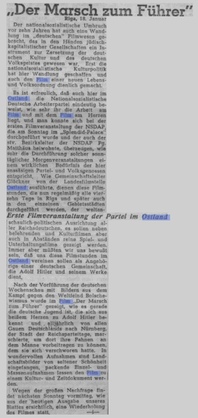
"The March to the Führer" film review
First film event of the Party in Ostland
Riga, January 18th
The National Socialist upheaval ten years ago also brought about a change in the "German" film system, which in the hands of Jewish capitalist society had been an instrument for the disintegration of German culture and the German people's spirit. It is gratifying that here in the East, too, the National Socialist German Workers' Party clearly proves how important it is to work on film and with film, and you could see yourself at the first NSDAP film event, which took place on Sunday in the “Splendid Palace" was convincingly carried out and that deputy District leader of the NSDAP Pg. Matthäus attended too, which showed the implementation of such sunny morning events have a real need here for resident Party and national comrades. Like community leader Glöckner from the Landesfilmstelle Ostland explained, these film lessons, which are now regularly held every fortnight in Riga and later also in the individual regional cities, serve the ideological and political orientation of all Reich Germans; in addition to educational and cultural films, pure feature and entertainment films are also to be shown at intervals.
But we should always be aware that these film lessons in the East should unite us as members of a German community that serves Adolf Hitler and his work.
After the presentation of the German newsreel with pictures from the fight against the world enemy Bolshevism, the film "Der Marsch zum Führer" showed what it is like the German youth who profess their hearts to Adolf Hitler and every year from all Gau in Germany to Nuremberg, the city of the Nazi party rallies, marched to raise their flags there to be able to carry past the man to whom they had sworn fidelity. In wonderful shots, landscapes of rare beauty are captured, gripping individual and mass recordings turn the film into a cultural and contemporary document.
Because of the great demand, the film is being repeated and will take place next Sunday morning.
-------------------––––––––––––––––––––––
from Deutsche Zeitung im Osten, Riga - 10. Juni 1943.

FILM IN THE EAST – Annual Report of the Zentral-Film-Gesellschaft Ost.
At the start of the year 1942 the newly founded “Zentral-Film-Gesellschaft Ost” and its subsidiaries “Ostland” and “Ukraine-Film G.m.b.H.” presented their first annual report.
What can be gathered from this account was the great difficulties in developing a film industry in the East, since the Bolsheviks had throughly destroyed the cinemas, projection equipment, film copying machinery, and workshops. Despite this, the corporation in its first year has succeeded in setting up 173 cinemas in the Eastern Territories, which 19 million people attended. In the Ukraine 265 cinemas are playing, which between January and September 1942 counted almost 3 million audience members.
At this time it was relatively easy to show good German feature films and newsreels, but there were great obstacles to overcome in producing its own films. The Zentralfilmgesellschaft considered the filming of its own productions, so far as possible, that one could with suitable filmmaking, bring the nature of the Eastern landscapes and its inhabitants closer to the German people. The prerequisites for an in-house production are still relatively cheap in the East, while in the Ukraine the "Ukraine-Film GmbH" has had to limit itself to outdoor shots. It is hoped, however, that after the restoration of the "Great Studio" in Kiev, that interior shots will also begin.
So far, a number of documentary films have been filmed. Films as educational materials in the schools has also been introduced. So far about 7600 Ostland schools have been looked after film–wise by the State Offices of the Reich Commissioner Ostland in Riga. On top of that, the major cities of the General District - District Film Offices have been set up, and the creation of additional local offices is in preparation. Prerequisite for the start of film work in the schools was the appropriate training of teachers, who firstly went through three to four day courses carried out by the State Offices, Riga. Further training will now follow through the District Film Offices.
© Translation 2020 by German Films Dot Net. All rights reserved.
--------–––––––––––––––––––––
from Deutsche Zeitung im Osten, Riga - 19. September 1943.

FILM IN THE EAST – Arranging German cultural work
Recently in the ‘Splendid Palace’ cinema in Riga, in a festive act the complete handover of 25 cinemas to their earlier owners gave cause for a talk by the Company Head of Ostland-Film GmbH, Dr. Von Lepel, who at the same time is the Distribution Chief of Zentralfilmgesellschaft Ost in Berlin, under whom is not only Ostland Film GmbH but also Ukraine-Film GmbH, with headquarters in Kiev.
The task given to Ostland-Film-Gmbh by the Reich Commissioner, namely the fiduciary management of Filmmaking in the Eastern Territories, is now given over to “Film Operations East“ (“Filmbetriebe Ost”) which later will carry the title “Cinema Companies East” (“Lichtspiele Ostland”). Still remaining in their fiduciary management are the resettled property and movie theaters from Jewish assets, until the handover to new owners, whereby the livelihood of a group of proven and skilled frontline soldiers should also be considered.
Through the disengagement of the fiduciary administration, the Ostland Film Company can then dedicate itself ready and unhindered as the mediator of German film production in the East. It will, even more than before, build bridges for better understanding, and that is why a special careful selection of screened films with respect to the tastes of the population groups shall be made. Almost all of the produced films in Germany arrive in the East for presentation, in which for easily understandable reasons, films with heavy dialect have to take a back seat. It will therefore not always be possible, at the same moment, to bring East a film that is given its premiere in Germany, such as was the case of the great Agfacolor film Die golden Stadt.
It takes a certain amount of time to prepare the subtitling of a film is the various native languages.
The subtitling, that is the insertion of a written script, in Latvian, Estonian, Lithuanian, Polish, White Ruthenian, and Russian for the German spoken text, whereby the Ostland Film GmbH has tried hard to help the enjoyment of a film by keeping the translation as short as possible and sufficient. Continuous technical improvement is also sought for this.
Given the necessary savings in raw film, it goes without saying that the first copies of each new film should first be used by the Wehrmacht support staff. That sometimes explains why a film is available to soldiers somewhat earlier in certain cinemas.
In the near future the Ostland Film GmbH will, next to German films, also present some foreign films, e.g. French films (Continental) and such as films being prepared for subtitling from Prague Productions. Also the best films of older German productions which have not yet been screened in the East shall be shown to film audiences. Through the destructiveness of the Bolsheviks, the condition of many cinemas and scarce seating available to audiences has prolonged the run of films to make them accessible to cinema-lovers.
More will be reported later about the in depth plans for long–established productions.
For the execution and planning of all tasks of Ostland Film GmbH the collaboration of the skilled workers has been secured, so that the bridge of the mediation of German cultural creation in film stands on strong pillars and allows the best to be expected.
F.M.–O.
© Translation 2020 by German Films Dot Net. All rights reserved.
----------––––––––––––––––––
from Deutsche Zeitung im Osten, Riga - 2. Oktober 1943.

FILM TRAVELS TO THE EAST – Most motion picture theaters in Lithuania General District
After the successful re–privatization of cinemas in General District Latvia, it is not only in this land, but also in Estonia, Lituania, and White Ruthenia (i.e. the eastern part of present-day Belarus) where the task remains unchanged – the planned supply of new films. As is well known, this supply works through film distribution, which today lies with two Companies – first, the “Ufa” (“Universum-Film-Akten-Gesellschaft”) with its foreign departments as major distributor; and in the East by the Zentralfilmgesellscahft (ZFO), the Ostland Film GmbH, Riga; through which German films from the Reich are distributed across the entire Eastern Territories through branch offices.
Through ZFO-GmbH all German films from the seven film production houses “Ufa,” “Tobis,” “Berlin-Film,” “Terra,” “Bavaria,” “Prag-Film” and “Wien-Film” come here for presentation. Branch offices for film distribution are in Riga, Reval, Kauen and Minsk, as well as subsidiary offices in Vilnius, Baranowitsche and Gleboki (White Ruthenia/ i.e. Eastern Beloruss).
As part of an import quota, films are sent from here to the private owners of cinemas and to the individual theaters of Cinema Companies East (“Lichtspiele Ostland”). In practice, the following numbers indicate the meaning and the scale of film distribution companies in the East: Latvia has 50 cinemas, of those 17 are in Riga and in the other cities 33 - Estonia has 48 cinemas – Reval (i.e. present-day Tallinn) has 12 cinemas alone. Lithuania shows the maximum with 57 cinemas, whereby Kauen has eleven and Vilnius six. White Ruthenia has 40 cinemas, but only three in Minsk.
To outline the overall picture even more closely, the number of theater seats in the largest cinemas should also be mentioned. In first place is Latvia’s largest movie theater, ‘Splendid Palace,’ in Riga with 921 seats; Estonia follows with 896 seats in its ‘Gloria Palace’ this Reval business hardly makes competition with Lithuania, whose ‘Helios’ cinema in Vilnius has but 743 seats. ‘Forum’ cinema in Kauen has 693 seats, and the second-to-last is ‘the White Ruthenian Cinema’ in Minsk with 396 seats. (In Minsk there is also a cinemas for German citizens with 150 seats, called the ‘Heimat’ cinema.)
Here and there one has been forced to stride towards new construction of cinemas due to increasing attendances, the planning drafts are made in Berlin for reasons of expediency. According to these simple designs are located, for example, two new cinemas in Vilnius. And also in Dorpot has Ostland Film GmbH done quite a job, whereby the “Deutsche Theater,” unused for a long-time, has been renovated as a modern cinema with 500 seats and has received a new name – ‘Victoria.’ Not uninteresting is also the fact that many of the new seats furnished for the Ostland cinemas are procured from the Reich, which are produced there in series.
As an intermediary and film distributor, Ostland Film HQ does not limit itself to simply passing on well-packaged films that are sent on the railroad or on the airplane (when especially fast delivery is needed). Usually films exported to the East must be checked technically before they reach cinemas for projection – a process which is indispensable. A 2000 to 3000 meter long film is divided into 600 meter spools and packed in single cases. Meter by meter the celluloid footage must be subjected to examination on the editing bench, scanned by experts and also examined for degradation of quality through an enlargement lens. Even a light scratch will be carefully noted in the booklet by means of corresponding technical drawings. Not content with this, the small projection room with few seats is in use day after day hours long in blackout, where the proofing continues - as far as technically, as well as purely in terms of content.
The technical preparatory work is by no means finished, as a motion picture from the Reich is produced in the German language. The film distributor is forced to deal with the pure problem of language, and to remedy this through translations. An agile translator receives the so–called “Title List” with the film’s dialogue, namely a small printed booklet, and has now the task to write down in the respective native language an abbreviated version of the words on the screen. In short, brevity is the soul of wit here, because if the whole textbook were reproduced unchanged, the result would be a whole novel of considerable length. The text — the result of the translation, is printed on paper and then photographed in the laboratory. This creates a second film strip with legible text next to the actual film. This second film tape runs during the film screening in a special projection device that projects the letters onto the screen.
--------
from Deutsche Zeitung im Osten, Riga - 2. December 1943
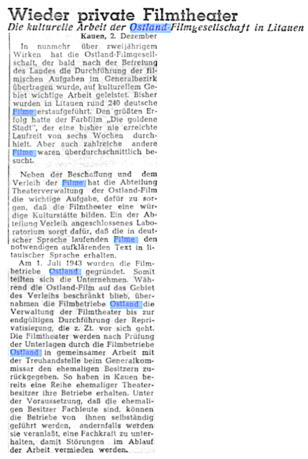
Private movie theaters again
The cultural work of Ostland Filmgesellschaft in Lithuania
Kauen, December 2nd [1943]
In over two years of activity, the Ostland-Filmgesellschaft, which soon after the liberation of the country was entrusted with the implementation of the cinematic tasks in the general district, undertook important work in the cultural field. So far there have been around 240 German films premiered in Lithuania. The color film "Die goldene Stadt" had the greatest success and lasted an unprecedented running time of six weeks. But also numerous others films received above–average attendances.
In addition to the procurement and distribution of the films, the Theater Administration Department of Ostland–Film has the important task of ensuring that the film theaters form a worthy cultural site. A laboratory attached to the distribution department ensures that the films running in German receive the necessary explanatory text in Lithuanian.
On July 1, 1943, the Ostland film company was founded. Thus the companies split up. While Ostland-Film remained limited to the area of distribution, the Ostland Film operations took over the administration of the film theaters until the re–privatisation is finally carried out. After the documents have been checked by Filmbetriebe Ostland, which will work together with the General Commissioner for the film theaters to be returned to the trusteeship of the former owners. A number of former theater owners have already kept their businesses in Kauen. Provided that the former owners are professionals, the companies can be run independently by them; otherwise they will be prompted to maintain a specialist so that disruptions in the work flow are avoided.
-----------------------------
